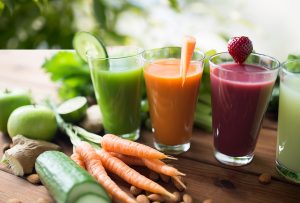A nutrition article in CNN noticed that juicing loses fiber and nutrients. Lately it has become popular to start the day with a glass of fruit juice or vegetable juice. But the problem is that both fiber and some nutrients like antioxidants and bioflavonoids get lost in the process.
Robin Foroutan, an integrative medicine dietitian and spokesperson for the Academy of Nutrition and Dietetics said: “You do lose fiber in fruit and vegetable juices, and that results in juices having the ability to spike your blood sugar in a more dramatic way than if you ate the actual fruit or vegetable.”
Fiber content important
For instance ¼ cup of raisins has 2 grams of fiber in it, but also 29 grams of sugar, translating into 130 calories. Of course, drying fruit also increases the sugar content, as this example shows! Conversely, ½ cup of raspberries contains 4.6 grams of fiber and has only 20 calories. This choice is definitely a winner in comparison to raisins.
Use the Internet to learn about the fiber content of the various foods while you keep an eye on sugar content and calories as well. The idea is to maximize the fiber content in your food intake by cutting out fiber empty foods and adding fiber rich foods as much as possible.
Cardiovascular benefit from fiber in food
Apart from reducing colon cancer incidence fiber has also gained recognition for prevention against heart attacks and strokes. It turns out that the enterohepatic pathway is interfered with through the intake of fiber. Cholesterol from bile is bound to fiber in the gut and transported to the sewer instead of being taken up through the enterohepatic pathway, which includes the portal vein system and the liver. The end result is that triglycerides and LDL cholesterol fall, while HDL cholesterol (the good cholesterol) is raised, and hardening of the arteries slows down significantly. The patient lives longer, heart attack and stroke rates go down, and there is less disability.
Minimizing fiber loss through other methods than juicing
You can use a blender or a food processor to achieve juicing. This does not yield a clear juice, but this method will leave all of the fiber in the juice. And the food processor or blender pulverizes the fiber. Alternatively you could use a juicer and put the fiber back into the juice- even though this does not make much sense! But your blood sugar curve is still somewhat higher with any of these methods than if you just eat the fruit alone. It takes some time to eat the fruit, as you have to chew it. The fiber in the bites you swallow will take time to disintegrate. This allows for a slow release of the fruit sugar, which makes it easier for the insulin secretion of the pancreas to deal with the sugar from the fruit.
The myth of getting rid of toxins and losing weight with fruit juice
There is an Internet culture of false truths. Fruit juice has a lot of calories. To hope that you lose weight with juicing is a fallacy. It won’t happen, because you still take in a lot of calories. For one glass of apple juice you are juicing approximately three apples. But normally you do not consume three apples in one sitting! If you want to lose weight, you need to cut out added sugar and starchy foods (potatoes, rice, bread and pasta). But you also want to get rid of processed foods in your diet. This includes wheat, which is contained in a lot of processed foods. Wheat stimulates your appetite and can break down your gut wall to produce leaky gut syndrome.
Fruit juices and vegetable juices do not detox your system
Also, fruit juices and vegetable juices do not detox your system as you always hear on many nutritional blogs. If you want to detox, see an intravenous chelation expert. EDTA chelation and glutathione chelation can take out heavy metals from your system and give you more energy.
Eat a well balanced diet like a Mediterranean diet
If you really crave a fruit juice or vegetable juice, limit it regarding the amount. Eat diversified foods, have some healthy fats (nuts, avocado, 85% chocolate), healthy protein and low-glycemic carbs. Your protein can come from vegetables (beans, chick peas, lentils or alfalfa sprouts) or from meat or fish. Keep in mind though that red meat is a carcinogenic. But you can eat turkey meat or chicken instead.
Conclusion
More is not always better. This is also true for fruit or vegetable juices. Your teeth need the chewing to stay healthy. Slow absorption of well-chewed food from the gut is what your body needs. In addition your gut needs fiber. Even our blood vessels and heart benefit from the fiber in our food, because fiber in the gut reduces triglycerides and LDL cholesterol. This reduces our risk for heart attacks and strokes. A well-balanced Mediterranean diet is anti-inflammatory, which reduces our risk of getting a heart attack or stroke even further. If you must juice, use a method that involves a food processor or blender that will keep the fiber in your juice.
Don’t fall for myths
But don’t fall for myths like weight loss or detoxification from juicing. There simply is no medical evidence for this. Throwing out refined carbs as indicated will help with weight loss. If you want to discuss detoxification, talk to a chelation therapy expert. Remember that with juicing you are really processing a valuable food source, and as a result there is a loss of fiber and nutrients. Is it really worth it to fall for the juice hype? The answer should be clear: eat real fruit and vegetables and not a food that has been depleted of valuable nutrients!







